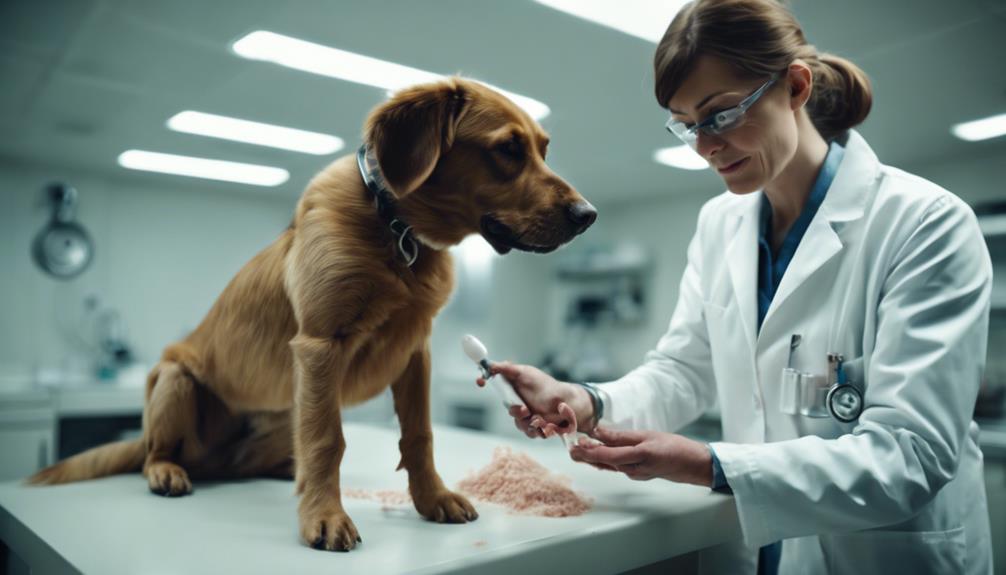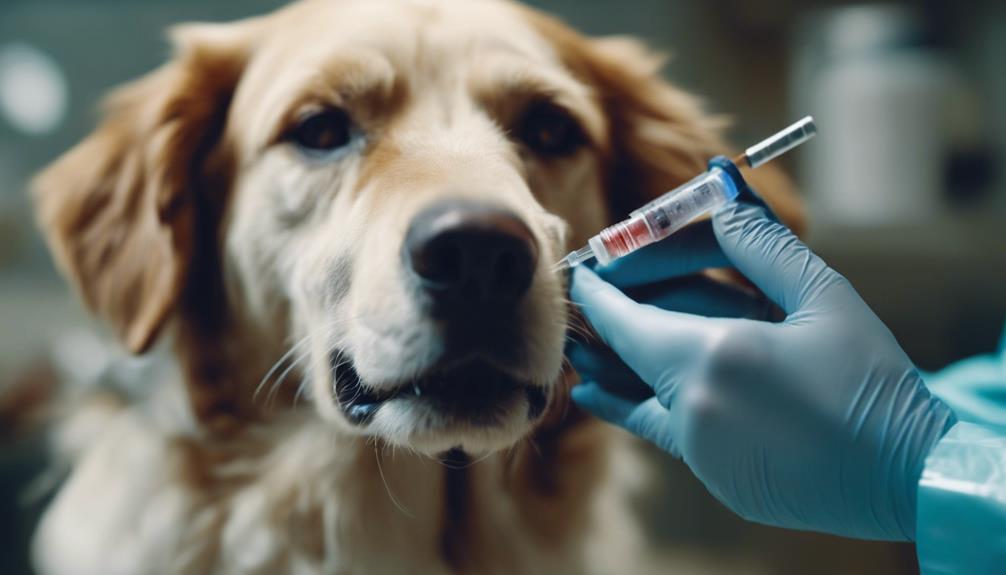With its potential to inflict serious harm on dogs and even pose risks to humans, tetanus in canines demands careful consideration and swift action. The subtleties of this bacterial infection may elude easy detection, and its implications can be severe if left unchecked.
Understanding the signs and steps to take when a dog exhibits symptoms of tetanus is crucial for safeguarding both the pet and those in its proximity. By exploring the nuances of this condition and the necessary strategies to address it, pet owners can equip themselves with the knowledge needed to navigate this concerning health issue effectively.
Key Takeaways
- Dogs are fairly resistant to tetanus, but it can result from puncture wounds.
- Tetanus signs can appear 3-21 days after a wound, with localized or generalized symptoms.
- Diagnosing tetanus in dogs relies on physical exams; tests are often unreliable.
- Prompt wound care is crucial to prevent tetanus; no preventive vaccine is available for dogs.
Recognizing Signs of Tetanus in Dogs
Frequently overlooked due to its rarity in dogs, recognizing the signs of tetanus is crucial for prompt diagnosis and treatment. Symptoms typically manifest 3 to 21 days post-wound, often appearing 5 to 10 days after injury.
Localized tetanus may initially present with muscle stiffness and spasms near the wound site. This localized form can progress to generalized tetanus, marked by spasms triggered by movement or stimuli.
Diagnostic tests for tetanus in dogs are unreliable, making physical exams paramount for diagnosis. Veterinarians assess symptom onset, wound history, and worsening condition.
Despite the challenges of diagnosis, vigilance in identifying tetanus signs is essential for swift intervention and effective management.
Understanding Tetanus Transmission Risk
Given the infrequency of tetanus cases in dogs, understanding the potential risks associated with tetanus transmission is paramount for pet owners and veterinarians alike.
Tetanus, caused by the bacterium C. tetani, can spread through contaminated soil, feces, or wounds. Although dogs are relatively resistant to tetanus compared to other species, the risk still exists, especially with deep puncture wounds that provide an entry point for the bacteria.
While tetanus transmission from a dog bite is rare, it can occur if the wound is contaminated with soil harboring the tetanus-causing bacteria. Prompt wound care, thorough cleaning of any injuries, and seeking medical attention if a dog bite occurs in a potentially contaminated environment are crucial steps to prevent tetanus transmission in dogs.
Importance of Prompt Tetanus Diagnosis

Recognizing the early signs of tetanus in dogs is crucial for prompt diagnosis and treatment. Since diagnostic tests for tetanus in dogs are unreliable, veterinarians often base their diagnosis on physical exams, inquiries about symptom onset, wound history, and worsening symptoms.
Additionally, diagnostic tests like bloodwork and X-rays can help rule out other conditions that may present similar symptoms. It is important to note that some wounds may have already healed before tetanus symptoms manifest, especially in cases of small unnoticed puncture wounds.
Therefore, prompt recognition of tetanus signs, such as muscle stiffness, spasms, and hypersensitivity to stimuli, is essential for initiating effective treatment and preventing the progression of the infection.
Tetanus Prevention in Canines
To safeguard canines against tetanus, prioritizing prompt wound care is fundamental in preventing the infection. Keeping wounds clean and properly treated can significantly reduce the risk of tetanus development in dogs. Additionally, ensuring that your pet's environment is free of potential tetanus-causing bacteria can also aid in prevention. Here is a helpful table summarizing key prevention strategies:
| Tetanus Prevention Tips for Canines |
|---|
| 1. Clean and disinfect wounds promptly |
| 2. Monitor wounds for signs of infection |
| 3. Keep your dog's living area clean and free of debris |
| 4. Avoid allowing your dog to roam in areas with high contamination risk |
| 5. Consult your veterinarian for any concerns about potential tetanus exposure |
Tetanus Shots for Dogs

In the realm of veterinary medicine, the administration of tetanus shots to dogs is a topic of consideration for pet owners and practitioners alike. When it comes to tetanus shots for dogs:
- Uncommon Vaccination: Tetanus is uncommon in dogs, leading to the absence of a preventive vaccine for them.
- Treatment Option: Dogs may receive tetanus antitoxin if they contract tetanus, as opposed to routine vaccination.
- Focus on Wound Care: Prevention methods emphasize prompt wound care to mitigate the risk of tetanus development in dogs.
These points underline the unique considerations surrounding tetanus shots for dogs, highlighting the rarity of the infection and the importance of tailored treatment approaches.
Comparing Tetanus in Dogs and Humans
When examining the occurrence of tetanus in dogs and humans, a notable disparity in susceptibility and vaccination strategies becomes apparent. Dogs are fairly resistant to tetanus compared to humans. The bacteria C. tetani, which causes tetanus, can spread through feces and survive in the environment for years.
In dogs, tetanus typically results from small puncture wounds, such as stepping on a nail, rather than from bites. While tetanus in humans is a more serious concern due to their higher susceptibility, dogs are less likely to develop the infection. This difference in susceptibility influences the need for preventive measures, with tetanus shots being more common in humans than in dogs due to their natural resistance to the disease.
Tetanus Antitoxin for Infected Dogs

Administering tetanus antitoxin to infected dogs aims to neutralize the tetanus toxin present in their system and prevent further progression of the disease. Tetanus antitoxin is crucial in managing tetanus cases in dogs.
Here are some key points to consider when using tetanus antitoxin:
- Timing is critical: Administer the antitoxin as soon as tetanus is suspected to halt the toxin's harmful effects.
- Dosage considerations: The appropriate dosage of antitoxin depends on the dog's weight and the severity of the infection.
- Monitoring for side effects: Watch for any adverse reactions to the antitoxin, such as allergic responses, and consult a veterinarian if any concerns arise.
Addressing Tetanus From Dog Bites
Addressing tetanus from dog bites involves prompt recognition of potential soil contamination in wounds to prevent the development of tetanus in affected individuals.
| Action | Description | Importance |
|---|---|---|
| Clean Wound | Thoroughly clean the wound with soap and water to remove soil particles. | Prevents introduction of tetanus-causing bacteria into the body. |
| Seek Medical Attention | Consult a healthcare professional if the wound is deep or shows signs of infection. | Early treatment can prevent tetanus development and complications. |
| Tetanus Vaccination | Ensure tetanus vaccination is up to date to provide immunity against the bacteria. | Reduces the risk of developing tetanus following a contaminated wound. |
Tetanus Resistance in Dogs

Understanding the mechanisms behind tetanus resistance in dogs sheds light on their unique immune response to the bacteria C. tetani. This resistance can be attributed to:
- Strong Immune Response: Dogs possess a robust immune system that can effectively combat the toxins produced by C. tetani.
- Natural Barrier: The skin and mucosal barriers in dogs play a crucial role in preventing the entry of tetanus-causing bacteria into their bodies.
- Limited Receptor Sites: Dogs have fewer receptor sites that the tetanus toxin can bind to, reducing the likelihood of toxin uptake and subsequent infection.
These factors collectively contribute to the lower susceptibility of dogs to tetanus compared to other species.
Dealing With Tetanus-Prone Wounds
When encountering wounds that are prone to tetanus infection in dogs, prompt and thorough wound care is essential to prevent potential complications. Tetanus is caused by the bacteria Clostridium tetani, which thrives in environments contaminated with feces and can enter the body through puncture wounds like stepping on a nail.
To reduce the risk of tetanus, it is crucial to clean the wound immediately with antiseptic solutions, remove any foreign objects, and consult a veterinarian for further evaluation. Monitoring the wound for signs of infection such as redness, swelling, or discharge is important.
Seeking veterinary care promptly can help prevent the development of tetanus and ensure the well-being of your dog.
Tetanus Vs. Other Pet Infections

Comparing tetanus to other common pet infections provides valuable insights into the different risks and preventive measures associated with these health concerns.
- Tetanus:
- Rare in dogs but can result from puncture wounds.
- No preventive vaccine for dogs; focus on wound care.
- Dogs may receive tetanus antitoxin if infected.
- Eye Infection in Cats:
- Redness, discharge, or squinting around the eye.
- Prompt vet visit for diagnosis and treatment.
- Preventive measures include regular eye check-ups.
- Labored Breathing in Dogs:
- Rapid breathing, wheezing, or blue-tinged gums.
- Immediate veterinary attention necessary.
- Underlying causes vary and require individualized treatment.
Conclusion
In conclusion, vigilance is crucial in recognizing and addressing tetanus in dogs, as this bacterial infection can pose serious health risks to both pets and humans. Understanding the signs, transmission risks, and preventative measures is essential in safeguarding canine companions from this potentially deadly disease.
By prioritizing prompt diagnosis, proper wound care, and vaccination protocols, pet owners can take proactive steps to protect their furry friends and prevent the spread of tetanus.




